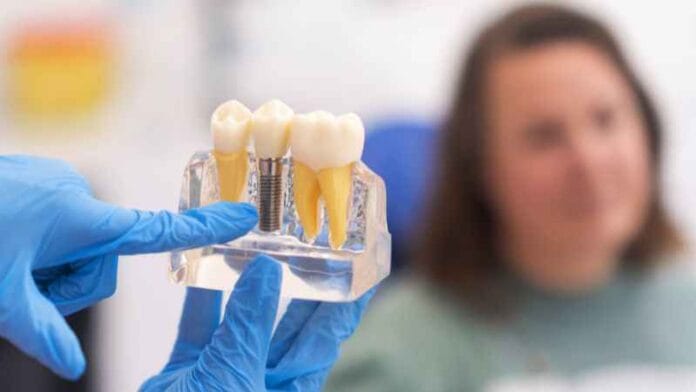Uncovering the Osseointegration Process
Dental implantology centers on the osseointegration process, where living bone directly bonds to an implant’s surface. Furthermore, this process is key to the Benefits of Dental Implants success. Osseointegration happens in stages:
- Surgical Stage: After the initial implant placement, a healing abutment facilitates mucosal healing.
- Secondary Stage: Mineralized bone tissues gradually fill the gaps between the implant and the bone, securing the foundation for a prosthesis.
- Tertiary Stage: Completed over several months, new bone formation continues around the implant, strengthening the jaw’s support system.
The success of osseointegration is evident in the high long-term survival rates of Dental implants – Wholedent, averaging over 95% in healthy individuals.
Mastering Implant Design for Clinical Success
An effective dental implant design is a fusion of art and science, tailored to different clinical applications and patient scenarios. Considerations for implant design include:
- Thread Design: Varying thread patterns optimize initial stability. Especially in compromised bone.
- Surface Texturing: Rough surfaces can promote faster osseointegration.
- Platform Switching: Using a smaller-diameter abutment on a larger diameter implant can help preserve bone levels.
- Biologic Width: Ensuring the implant-abutment junction respects the biologic width is critical to peri-implant tissue health.
Understanding these design factors enables dental professionals to select the most appropriate implant system and components for each patient case, be it a single tooth replacement or a full-arch restoration.
The Influence of Biomaterial Properties
The material composition of dental implants significantly impacts osseointegration and long-term peri-implant health. Properties to consider include:
- Biocompatibility: The implant material must be non-reactive and should not elicit an immune response.
- Mechanical Properties: Implants must withstand occlusal forces without failure.
- Chemical Surface Modifications: Coatings can enhance the implant’s interaction with bone, accelerating osseointegration.
- Radiopacity: Radiolucent implants can complicate follow-up assessments; implants with sufficient radiopacity are advantageous.
Selecting the right biomaterial for each patient’s need fosters predictable surgical outcomes and minimizes the risk of long-term complications.
Navigating Surgical Techniques
The method of implant placement, whether traditional or innovative, significantly affects patient recovery and long-term results.
Distinct surgical techniques include:
- Flapless Surgery: Minimally invasive, it reduces recovery time but requires precise pre-surgical planning and suitable bone and soft tissue anatomy.
- Guided Surgery: Utilizes computer-aided design to position implants with exceptional accuracy.
- Immediate Loading: In selective cases, implants can support a temporary prosthesis immediately after placement, offering patients immediate esthetics and function.
- Sinus Lifts and Bone Grafts: These adjunct procedures enable implant placement in atrophic maxillary and mandibular ridges, expanding the pool of eligible candidates.
Implementing appropriate surgical techniques requires comprehensive training, expertise, and careful patient selection, contributing to successful outcomes.
The Benefits of Dental Implants
The benefits of dental implants are more than just the restoration of a natural smile. They encompass functional advantages and oral health preservation, making them the gold standard for tooth replacement.
Advantages include:
- Enhanced Functionality: Implants mimic natural teeth, allowing for normal eating and speaking.
- Oral Health Conservation: Adjacent teeth remain untouched; implants prevent bone resorption, preserving facial structures.
- Durability: With proper care, implants can last a lifetime, outlasting traditional restorations.
- Cosmetic Appeal: Implants provide natural-looking esthetics, boosting patient confidence and quality of life.
Understanding and communicating these significant benefits to patients is integral to fostering trust and obtaining their informed consent for treatment.
Dissecting the Drawbacks of Implant Therapy
Despite their many advantages, dental implants are not without their drawbacks. Dental professionals need to be aware of these potential challenges to ensure comprehensive patient counseling. Drawbacks of dental implants include:
- Implant Failure: Contributing factors can include infection, poor surgical technique, or compromised patient health.
- Peri-implant Diseases: Analogous to periodontal diseases, these infections can lead to loss of supporting bone and implant failure.
- Treatment Complexity: Implant therapy can be more complex and costly than traditional prosthetic options, requiring careful patient selection and planning.
- Maintenance Challenges: Long-term maintenance is necessary to protect the investment and the patient’s oral health.
Clear communication about these drawbacks helps manage patient expectations and supports a transparent treatment process.
Identifying Ideal Candidates for Benefits of Dental Implants
Patient selection is a critical part of the implant treatment process, necessitating a thorough evaluation of a patient’s medical history, oral health, and anatomical features to assess their suitability.
An ideal candidate for dental implants is generally in good health to undergo surgery safely, has a disease-free mouth or manageable dental conditions, possesses adequate bone density and depth to support the implant, and shows commitment to follow post-operative care and maintenance regimens for the implant’s longevity.
Careful consideration of these criteria ensures predictable outcomes and high patient satisfaction.
The Future of Dental Implantology
The field of dental implants is rapidly advancing, driven by improvements in materials, techniques, and digital technologies. With the integration of 3D printing, guided surgery, and biology-informed materials, the future looks bright.
These innovations aim to increase precision and outcomes, including customized implants designed for individual needs, materials that enhance bone healing for better osseointegration, and regenerative therapies that leverage the body’s healing power for superior bone support. Dental professionals must keep up with these trends to stay at the forefront of implant dentistry.
In Conclusion Benefits of Dental Implants
Dental implants offer a multitude of benefits for patients, with high success rates and the potential for long-term aesthetic and functional outcomes. However, careful consideration of patient candidacy, understanding the osseointegration process, mastering implant design, and navigating surgical techniques are all critical components to ensuring successful implant therapy.
As the field continues to evolve, dental professionals must remain vigilant in staying updated and incorporating new techniques and materials to provide the best possible outcomes for their patients.


